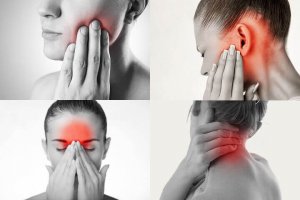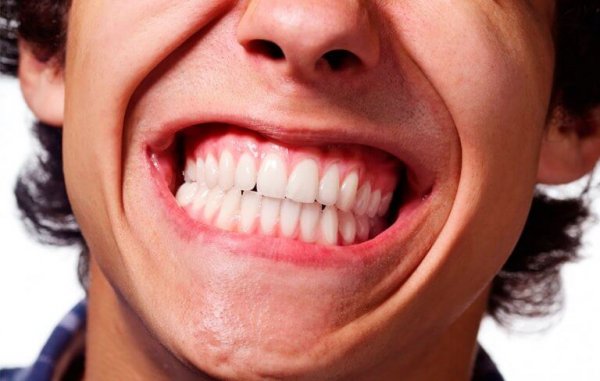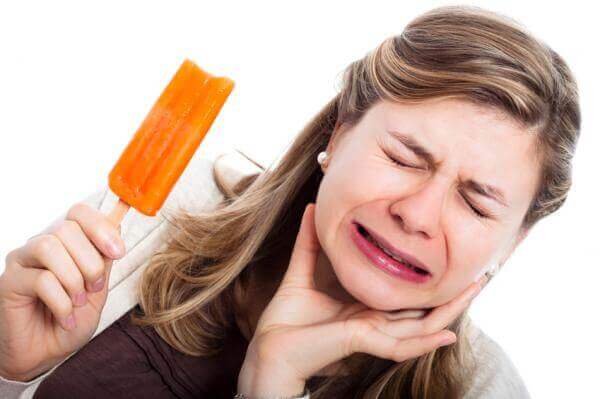Teeth Grinding: Causes, Symptoms, and Treatments

Teeth grinding, or bruxism, is a dental problem — but it can have very serious consequences on how your brain works.
It consists of clenching your upper and lower teeth together and grinding them by moving them back and forth over each other. This tends to be something we do unconsciously, which can make prevention or treatment quite complicated.
Teeth grinding can happen during the day or night, while it’s a bigger problem at night, since it’s harder to control. There’s no agreed-upon cause of bruxism, but it seems that daily stress can be a psychological trigger for many .
Bruxism affects men and women equally. It happens less frequently as we get older, as 14% of children show symptoms, while 12% of adolescents and only 8% of adults do.
An early diagnosis is fundamental to preventing dental health and sleep problems.

Causes and symptoms of teeth grinding
If we wake up with pain in our facial muscles or a headache, we we may have the most typical symptoms of bruxism. Teeth grinding causes tooth pain, loose teeth, and sometimes the literal wearing down of teeth.
Additionally, it destroys the bone that supports the tooth and causes problems in your joints, such as Temporomandibular joint dysfunction (TMD).
People with bruxism rarely notice that their teeth grinding. They don’t notice the symptoms either because in most cases they happen while the person is sleeping.
Symptoms like strains or tension of facial muscles only show up when teeth grinding reaches a certain point.
Sometimes there is tooth, jaw , facial, sinus, or ear pain. In some cases, there is pain throughout the whole head. If teeth grinding goes on for a long time, muscle strain can extend into the neck and shoulders.
- Stress and anxiety.
- Waking up during a period of light sleep, which can be one of the most evident symptoms of the disorder.
- Sleeping on your back.
- Diet.
- Sleeping habits.
- Incorrect alignment of the teeth.
Your brain will thank you for sleeping well.
Treatments for teeth grinding
The appropriate treatment is directly related to the cause, and it’s important to go right to the root and not just treat the symptoms.
Relaxation techniques can help greatly, since stress seems to be a leading cause of bruxism. Any initiative that effectively reduces stress can help, such as listening to music, reading, or walking.
For cases where the key factor is a psychological condition, such as anxiety, we recommend learning relaxation techniques. Physical therapy, anti-inflammatory medication, and muscle relaxants may be appropriate as well.

Seeing a therapist can also help reduce episodes of teeth grinding, as it helps the patient relax and learn self-control.
Steps aimed at lessening anxiety help control the influence that our hypothalamus and limbic system exert over the regulation of our muscles.
Treating bruxism means reducing symptoms and protecting our teeth. If the problem persists, see a specialist: an ear, nose and throat doctor, a sleep doctor, a physical therapist, or psychologist.
Bibliography:
Alcolea Rodríguez, J. R., Herrero Escobar, P., Ramón Jorge, M., Sol, L., Trinidad, E., Pérez Téllez, M., & Garcés Llauger, D. (2014). Asociación del bruxismo con factores biosociales. Correo Científico Médico, 18(2), 190-202.
Arreaza, A., Correnti, M., & Battista, V. (2010). Ansiedad como rasgo de la personalidad de un grupo de pacientes con liquen plano bucal. Acta odontol. venez, 48(2).
Da Acosta Álvarez, A., Alchieri, A., & Joao, C. Niveles de ansiedad y el impacto social en las personas con bruxismo. Interpsiquis [Internet]. 2012 [citado 19 Oct 2012][aprox. 8 pantallas].
Pérez, G., Vázquez, L., & Vázquez, Y. (2007). Bruxismo: Somatización del estrés en odontología. In Rev Forum científico (Vol. 21, No. 52, p. 5).
Pinto, F., & Washington, W. (2014). Bruxismo y Patologías relacionadas por hacinamiento y estrés psicofísico en pacientes del centro de rehabilitación social nº 2 de quito, en el período octubre 2013-marzo 2014 (Bachelor’s thesis, Riobamba: Universidad Nacional de Chimborazo).
Segura, M. G., Rodríguez, M. O., & Rojas, P. D. (2003). Tratamiento combinado a pacientes bruxopatas con férulas oclusal y psicoterapia. Correo Cientif Med Holguín, 7, 12.
Vicuña, D., Id, M. E., & Oyonarte, R. (2010). Asociaciones entre signos clínicos de bruxismo, ansiedad y actividad electromiográfica maseterina utilizando el aparato bite strip® en adolescentes de último año de enseñanza media (Secundaria). International journal of odontostomatology, 4(3), 245-253.
Teeth grinding, or bruxism, is a dental problem — but it can have very serious consequences on how your brain works.
It consists of clenching your upper and lower teeth together and grinding them by moving them back and forth over each other. This tends to be something we do unconsciously, which can make prevention or treatment quite complicated.
Teeth grinding can happen during the day or night, while it’s a bigger problem at night, since it’s harder to control. There’s no agreed-upon cause of bruxism, but it seems that daily stress can be a psychological trigger for many .
Bruxism affects men and women equally. It happens less frequently as we get older, as 14% of children show symptoms, while 12% of adolescents and only 8% of adults do.
An early diagnosis is fundamental to preventing dental health and sleep problems.

Causes and symptoms of teeth grinding
If we wake up with pain in our facial muscles or a headache, we we may have the most typical symptoms of bruxism. Teeth grinding causes tooth pain, loose teeth, and sometimes the literal wearing down of teeth.
Additionally, it destroys the bone that supports the tooth and causes problems in your joints, such as Temporomandibular joint dysfunction (TMD).
People with bruxism rarely notice that their teeth grinding. They don’t notice the symptoms either because in most cases they happen while the person is sleeping.
Symptoms like strains or tension of facial muscles only show up when teeth grinding reaches a certain point.
Sometimes there is tooth, jaw , facial, sinus, or ear pain. In some cases, there is pain throughout the whole head. If teeth grinding goes on for a long time, muscle strain can extend into the neck and shoulders.
- Stress and anxiety.
- Waking up during a period of light sleep, which can be one of the most evident symptoms of the disorder.
- Sleeping on your back.
- Diet.
- Sleeping habits.
- Incorrect alignment of the teeth.
Your brain will thank you for sleeping well.
Treatments for teeth grinding
The appropriate treatment is directly related to the cause, and it’s important to go right to the root and not just treat the symptoms.
Relaxation techniques can help greatly, since stress seems to be a leading cause of bruxism. Any initiative that effectively reduces stress can help, such as listening to music, reading, or walking.
For cases where the key factor is a psychological condition, such as anxiety, we recommend learning relaxation techniques. Physical therapy, anti-inflammatory medication, and muscle relaxants may be appropriate as well.

Seeing a therapist can also help reduce episodes of teeth grinding, as it helps the patient relax and learn self-control.
Steps aimed at lessening anxiety help control the influence that our hypothalamus and limbic system exert over the regulation of our muscles.
Treating bruxism means reducing symptoms and protecting our teeth. If the problem persists, see a specialist: an ear, nose and throat doctor, a sleep doctor, a physical therapist, or psychologist.
Bibliography:
Alcolea Rodríguez, J. R., Herrero Escobar, P., Ramón Jorge, M., Sol, L., Trinidad, E., Pérez Téllez, M., & Garcés Llauger, D. (2014). Asociación del bruxismo con factores biosociales. Correo Científico Médico, 18(2), 190-202.
Arreaza, A., Correnti, M., & Battista, V. (2010). Ansiedad como rasgo de la personalidad de un grupo de pacientes con liquen plano bucal. Acta odontol. venez, 48(2).
Da Acosta Álvarez, A., Alchieri, A., & Joao, C. Niveles de ansiedad y el impacto social en las personas con bruxismo. Interpsiquis [Internet]. 2012 [citado 19 Oct 2012][aprox. 8 pantallas].
Pérez, G., Vázquez, L., & Vázquez, Y. (2007). Bruxismo: Somatización del estrés en odontología. In Rev Forum científico (Vol. 21, No. 52, p. 5).
Pinto, F., & Washington, W. (2014). Bruxismo y Patologías relacionadas por hacinamiento y estrés psicofísico en pacientes del centro de rehabilitación social nº 2 de quito, en el período octubre 2013-marzo 2014 (Bachelor’s thesis, Riobamba: Universidad Nacional de Chimborazo).
Segura, M. G., Rodríguez, M. O., & Rojas, P. D. (2003). Tratamiento combinado a pacientes bruxopatas con férulas oclusal y psicoterapia. Correo Cientif Med Holguín, 7, 12.
Vicuña, D., Id, M. E., & Oyonarte, R. (2010). Asociaciones entre signos clínicos de bruxismo, ansiedad y actividad electromiográfica maseterina utilizando el aparato bite strip® en adolescentes de último año de enseñanza media (Secundaria). International journal of odontostomatology, 4(3), 245-253.
All cited sources were thoroughly reviewed by our team to ensure their quality, reliability, currency, and validity. The bibliography of this article was considered reliable and of academic or scientific accuracy.
- Alcolea Rodríguez, J. R., Herrero Escobar, P., Ramón Jorge, M., Sol, L., Trinidad, E., Pérez Téllez, M., & Garcés Llauger, D. (2014). Asociación del bruxismo con factores biosociales. Correo Científico Médico, 18(2), 190-202.
- Arreaza, A., Correnti, M., & Battista, V. (2010). Ansiedad como rasgo de la personalidad de un grupo de pacientes con liquen plano bucal. Acta odontol. venez, 48(2).
- Da Acosta Álvarez, A., Alchieri, A., & Joao, C. Niveles de ansiedad y el impacto social en las personas con bruxismo. Interpsiquis [Internet]. 2012 [citado 19 Oct 2012][aprox. 8 pantallas].
- Pérez, G., Vázquez, L., & Vázquez, Y. (2007). Bruxismo: Somatización del estrés en odontología. In Rev Forum científico (Vol. 21, No. 52, p. 5).
- Pinto, F., & Washington, W. (2014). Bruxismo y Patologías relacionadas por hacinamiento y estrés psicofísico en pacientes del centro de rehabilitación social nº 2 de quito, en el eríodo octubre 2013-marzo 2014 (Bachelor’s thesis, Riobamba: Universidad Nacional de Chimborazo).
- Segura, M. G., Rodríguez, M. O., & Rojas, P. D. (2003). Tratamiento combinado a pacientes bruxopatas con férulas oclusal y psicoterapia. Correo Cientif Med Holguín, 7, 12.
- Vicuña, D., Id, M. E., & Oyonarte, R. (2010). Asociaciones entre signos clínicos de bruxismo, ansiedad y actividad electromiográfica maseterina utilizando el aparato bite strip® en adolescentes de último año de enseñanza media (Secundaria). International journal of odontostomatology, 4(3), 245-253
This text is provided for informational purposes only and does not replace consultation with a professional. If in doubt, consult your specialist.







